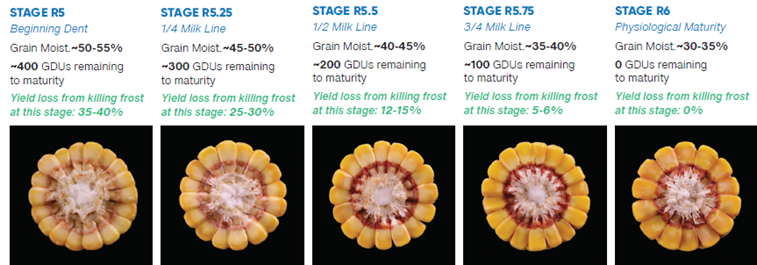Corn Drydown and Maturity
BY Dairyland Seed Agronomy Team
As we have moved from the month of September into October, more producers are starting corn grain harvest. As a result, many ask “How does corn (kernels) lose moisture?”.
- Kernels lose moisture by accumulating dry matter, as well as evaporate water loss.
- During the grain fill period, corn plants transfer photosynthate into kernels that increases kernel dry weight.
Kernels accumulate dry matter from the day of pollination (R1) to physiological matter (R6 -- often referred to as Black Layer). The table below tracks reproductive growth stages from days after tassel/silking and the approximate moisture at that stage.
|
Growth Stage |
|
Days After Silking |
Approximate Moisture |
|
Tassel / Silking |
R1 |
0 |
|
|
Blister |
R2 |
10-14 days |
85% |
|
Milk |
R3 |
18-22 days |
80% |
|
Dough |
R4 |
24-28 days |
70% |
|
Dent |
R5 |
35-42 days |
60% |
|
Black layer |
R6 |
55-65 days |
32-35% |
Physiological Maturity and Black Layer
- Physiological maturity, sometimes referred to as black layer, is the point at which the hard starch layer reaches the base of the kernel and kernel dry matter accumulation is complete.
- Kernel moisture at R6 or physiological maturity normally is from 32-35%, but varies due to differences in hybrid attributes and environmental conditions.
- Following physiological maturity, an abscission layer or “black layer” will form at the base of the kernel.
- Within the ear, this black layer normally forms at the kernels near the tip of the ear first and in a few days the kernels at the base will black layer as well.
- Black layer is used as a visual indicator of physiological maturity; however, this is not always true.
- Black layer formation is triggered when sucrose movement to the developing kernel stops.
- Black layer formation triggered by environmental stresses can occur prior to physiological maturity, which shuts down grain fill prematurely. When this happens. test weight is normally negatively affected.

Drydown Following Maturity
- Individual kernel drying occurring after black layer is solely due to evaporative moisture loss.
- Corn drydown rate is linked to Growing Degree Unit (GDU) accumulation.
- Generally, corn drying from 30% down to 25% moisture needs around 30 GDUs per point of moisture
- Drying from 25% to 20% needs around 45 GDUs per point of moisture.
- GDU accumulation and drydown are greatest typically during the earlier and normally warmer part of the harvest season and decline as the weather gets colder.
- Constant or steady wind coupled with lower humidity levels also will impact how fast kernels will dry. Conversely, corn may not dry at all on days with high humidity or rainfall.
- Corn can drop one point of moisture per day under favorable drying conditions.
Hybrid Attributes that Affect Kernel Dry Down
- Husk Leaf Coverage - Leaf number, thickness and or tightness will negatively impact kernel dry down rates.
- Husk Leaf Senescence – The quicker these leaves die, the faster the grain will dry down.
- Ear Angle – Upright ears are more prone to capture moisture in the husks, which slows dry down.
- Kernel Pericarp Characteristics – Thinner or more permeable pericarp layers are associated with a faster drydown rates.
Enjoying our Agronomy Updates? Suggestions for topics you'd like us to weigh in on? Drop us an email at dairylandseed@dairylandseed.com. We'd love to hear from you!
 |
 |
 |
 |
 |
| Brian Weller Western Region 507.456.3034 |
Dan Ritter Central Region 219.863.0583 |
Branden Furseth Northern Region 608.513.4265 |
Mark Gibson Eastern Region 260.330.8968 |
Amanda Goffnett Eastern Region 989.400.3793 |
